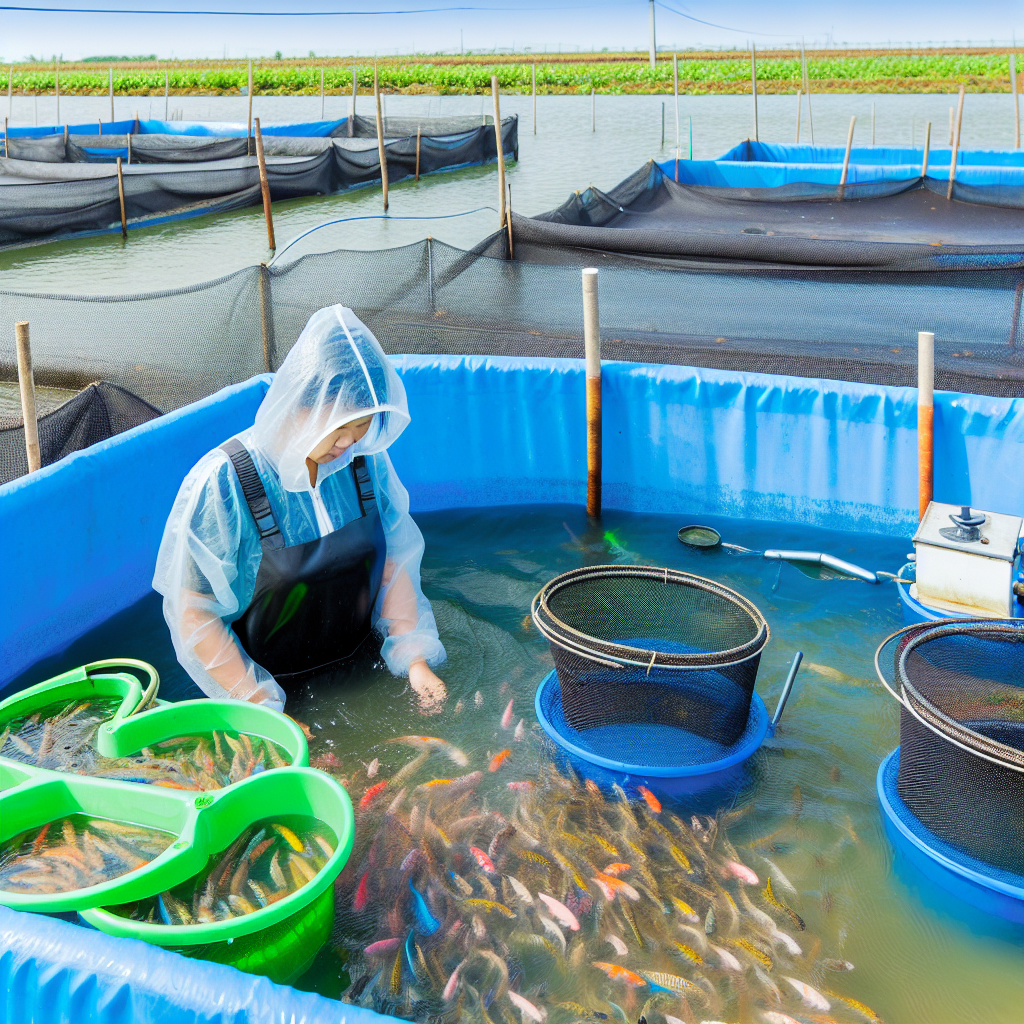Introduction to Aquaculture and Fish Breeding
Aquaculture refers to the farming of aquatic organisms.
This includes fish, crustaceans, mollusks, and aquatic plants.
It represents a vital industry that supports global food needs.
The practice offers sustainable sources of protein for many communities.
Fish breeding within aquaculture systems is crucial for production.
It enhances the availability of desired species for consumption.
Moreover, breeding ensures the sustainability of fish populations.
Successful fish breeding involves understanding environmental requirements.
This includes water quality, temperature, and dietary needs.
The Role of Genetic Selection
Genetic selection plays a significant role in fish breeding.
Aquaculture professionals select breeding stock carefully.
The goal is to enhance desirable traits in offspring.
These traits include growth rate, disease resistance, and feed efficiency.
Genetic diversity is essential for long-term success.
It protects populations against disease outbreaks and environmental changes.
Transform Your Agribusiness
Unlock your farm's potential with expert advice tailored to your needs. Get actionable steps that drive real results.
Get StartedOptimal Conditions for Breeding
Creating optimal conditions is vital for successful breeding.
Temperature regulation is critical during spawning periods.
Fish require specific water temperatures to breed effectively.
Water quality, including pH and dissolved oxygen levels, must be monitored.
Additionally, light patterns can influence breeding behaviors.
Providing suitable habitats also greatly impacts breeding success.
Feeding Practices for Breeding Fish
Nutrition is key in the breeding phase of aquaculture.
Healthy adult fish produce higher quality eggs and sperm.
Proper feeding strategies enhance the reproductive performance.
Formulated diets should meet specific nutritional requirements.
Supplementing diets with vitamins can support reproductive health.
Regular feeding schedules should be established during spawning.
Monitoring and Management Techniques
Regular monitoring of breeding stock is crucial for success.
Fish health assessments help identify any potential issues.
Behavioral observations also aid in understanding breeding readiness.
Implementing management practices ensures optimal breeding conditions.
Strategic planning minimizes stress during the breeding process.
Collaboration among aquaculture specialists can further enhance practices.
Understanding Species Selection for Breeding
Importance of Species Selection
Species selection plays a crucial role in aquaculture success.
Choosing the right species impacts growth rates and breeding efficiency.
Additionally, it affects disease resistance and adaptability.
Hence, proper selection can lead to higher yields and profitability.
Assessing Environmental Conditions
Before selecting a species, assess your environmental conditions.
Consider water temperature, salinity, and pH levels.
Showcase Your Farming Business
Publish your professional farming services profile on our blog for a one-time fee of $200 and reach a dedicated audience of farmers and agribusiness owners.
Publish Your ProfileUnderstand that species have varying tolerance to these factors.
Matching species to specific conditions enhances survival rates.
Market Demand Considerations
Market demand should guide your choice of species.
Analyze local and global trends in fish consumption.
Popular species often enjoy higher prices and demand.
Additionally, emerging markets can present new opportunities.
Availability of Stock and Genetic Quality
Ensure the selected species is readily available for stocking.
Investigate suppliers for their genetic quality and health standards.
Strong genetic stock contributes to robust breeding outcomes.
Moreover, it minimizes risks associated with inbreeding.
Compatibility with Other Species
Consider species compatibility if multiple types are bred together.
Incompatible species can lead to aggression and stress.
Promoting peace within tanks enhances overall aquaculture success.
Furthermore, mixed-species systems can maximize space and resources.
Long-term Sustainability
Opt for species that support long-term sustainability goals.
Sustainable species contribute to ecological balance in the habitat.
Additionally, they help maintain resource availability for future generations.
Therefore, evaluate the environmental footprint of each species.
Creating Optimal Breeding Conditions in Aquaculture Systems
Understanding Water Quality
Water quality is vital for successful fish breeding.
It influences growth, reproduction, and overall health.
Aquaculturists should monitor parameters regularly.
These parameters include temperature, pH, and dissolved oxygen levels.
Maintaining suitable water conditions enhances breeding success.
Establishing Proper Stocking Density
Stocking density plays a significant role in breeding outcomes.
Overcrowding can lead to stress and decreased reproduction rates.
Conversely, too few individuals can hinder genetic diversity.
Finding a balance is crucial for optimal breeding.
Aquaculturists should calculate density based on species needs.
Utilizing Natural Breeding Stimuli
Natural stimuli can trigger breeding behaviors.
Changes in temperature and light conditions often encourage spawning.
In addition, introducing specific feed types can stimulate reproduction.
Researching species-specific cues is beneficial for aquaculturists.
Implementing Nutritional Strategies
Nutrition directly impacts fish health and reproductive success.
High-quality diets should contain essential vitamins and minerals.
Feeding frequencies also affect breeding behavior.
It is crucial to adjust diets during breeding seasons.
Furthermore, enhancing diets with fatty acids can promote spawning.
Creating Safe and Comfortable Environment
A secure environment reduces stress during breeding.
Providing adequate hiding spots can boost fish comfort.
Additionally, avoiding disturbances during the breeding period is essential.
Showcase Your Farming Business
Publish your professional farming services profile on our blog for a one-time fee of $200 and reach a dedicated audience of farmers and agribusiness owners.
Publish Your ProfileA stress-free environment leads to higher reproductive success.
Monitoring and Record-Keeping
Consistent monitoring of breeding conditions is necessary.
Aquaculturists should maintain records of water quality and stocking density.
Tracking reproductive rates and health helps identify trends.
Moreover, thorough documentation supports continuous improvements.
This data can guide future breeding strategies effectively.
Explore Further: Common Challenges in Exotic Livestock Management
Nutritional Requirements for Breeding Fish
Understanding Nutritional Needs
Nutritional requirements are essential for breeding fish successfully.
Different fish species have varying dietary needs.
Proper nutrition supports growth, reproduction, and overall health.
Fish diets must include proteins, lipids, carbohydrates, vitamins, and minerals.
Moreover, a balanced diet enhances resistance to diseases.
Protein Requirements
Protein serves as a fundamental building block for fish growth.
High protein content is crucial during the breeding season.
Fish require around 30-45% protein in their diet to thrive.
Quality protein sources include fish meal and soybean meal.
Incorporating essential amino acids promotes optimal health and reproduction.
Lipid Requirements
Lipids are vital energy sources for breeding fish.
They also assist in the absorption of fat-soluble vitamins.
A diet containing 10-20% lipids is generally effective.
Fish oil is an excellent source of essential fatty acids.
These fatty acids improve reproductive performance and egg quality.
Carbohydrate Needs
Carbohydrates provide energy and promote metabolic functions.
While fish do not require high levels of carbohydrates, a balanced amount is beneficial.
Including 20-30% carbohydrates in the diet enhances growth performance.
However, excess carbohydrates may lead to health issues.
Vitamin and Mineral Requirements
Vitamins and minerals play critical roles in various bodily functions.
They support immune health, reproduction, and overall metabolism.
Vitamins A, D, E, and B-complex are particularly important.
Calcium and phosphorus are essential for bone development in fish.
Providing a mineral-rich diet promotes strong and healthy offspring.
Dietary Supplementation
Supplementation can enhance fish diets significantly.
Natural additives, such as spirulina and garlic, boost health and growth.
Using probiotics may improve digestion and nutrient absorption.
Moreover, supplements can promote reproductive efficiency.
Monitoring and Adjusting Diets
Regular assessment of fish health is crucial for effective breeding.
Adjusting diets based on fish growth and behavior can yield better results.
Employing biomanagement strategies ensures optimal nutrient availability.
Continuous research helps refine dietary needs for different fish species.
Find Out More: Energy-Efficient Solutions for Sustainable Aquaculture
Showcase Your Farming Business
Publish your professional farming services profile on our blog for a one-time fee of $200 and reach a dedicated audience of farmers and agribusiness owners.
Publish Your ProfileMonitoring and Managing Water Quality
Importance of Water Quality in Aquaculture
Water quality directly impacts fish health and growth rates.
Moreover, it influences reproductive success and disease resistance.
Maintaining optimal water parameters sustains a viable aquaculture operation.
Key Water Quality Parameters to Monitor
Temperature is a crucial factor for fish welfare.
Additionally, dissolved oxygen levels must remain sufficiently high.
pH levels affect metabolic processes within fish.
Ammonia, nitrite, and nitrate concentrations must also be monitored closely.
Finally, regular checks of turbidity and salinity are essential.
Methods for Water Quality Monitoring
Utilize water testing kits for immediate analysis.
Automated sensors offer real-time data for constant monitoring.
Laboratory analysis can confirm accurate readings and trends.
Strategies for Managing Water Quality
Implement regular water exchanges to maintain healthy conditions.
Use aeration systems to enhance dissolved oxygen levels.
Employ biofilters to reduce harmful waste products.
Add beneficial bacteria to aid in the biological filtration process.
Addressing Water Quality Issues
Swiftly identify the source of any water quality issues.
Adjust water parameters gradually to avoid stress on the fish.
Implement remedial actions based on specific problems encountered.
Regularly educate staff on water quality management techniques.
Best Practices for Routine Monitoring
Establish a consistent schedule for testing water parameters.
Document changes in water quality to identify trends over time.
Train personnel on the importance of monitoring water quality.
Encourage a proactive approach to managing aquatic environments.
Uncover the Details: Technology Innovations in Livestock Transportation
Implementing Effective Breeding Techniques
Choosing the Right Fish Species
Select fish species that are well-suited for aquaculture systems.
Consider factors such as growth rate and market demand.
Additionally, assess the environmental needs of each species.
Setting Up Optimal Breeding Conditions
Establish water quality parameters for successful breeding.
Maintain appropriate temperature, pH, and oxygen levels.
Regularly monitor these conditions to ensure stability.
Designing a Breeding Program
Create a comprehensive breeding plan based on specific goals.
Include genetic selection to enhance desirable traits.
Also, incorporate a schedule for breeding and harvesting.
Utilizing Proper Breeding Techniques
Implement methods such as selective breeding for optimal results.
Use controlled environments to enhance breeding success.
Furthermore, ensure appropriate ratio of males to females for breeding.
Monitoring Reproductive Success
Track and record breeding outcomes for analysis.
Identify factors that contribute to successful reproduction.
Moreover, adjust breeding strategies based on data collected.
Ensuring Health and Nutrition
Provide a balanced diet to breeding fish for health.
Showcase Your Farming Business
Publish your professional farming services profile on our blog for a one-time fee of $200 and reach a dedicated audience of farmers and agribusiness owners.
Publish Your ProfileSupplement with vitamins to promote reproductive performance.
Regularly check health status to prevent disease outbreaks.
Find Out More: Selecting the Best Routes for Livestock Transport

Importance of Genetic Management in Fish Breeding
Enhancing Fish Stock Quality
Genetic management significantly improves fish stock quality.
It involves selecting the best breeding individuals.
Consequently, this leads to healthier and more resilient offspring.
Increasing Productivity
Genetic diversity enhances overall productivity in aquaculture systems.
By managing genetics, farms can optimize growth rates.
Moreover, this allows for better feed conversion ratios.
Mitigating Genetic Disorders
Effective genetic management helps mitigate genetic disorders.
Inbreeding can lead to detrimental traits in fish populations.
However, by monitoring genetics, farms can maintain healthy breeding stocks.
Supporting Sustainable Practices
Genetic management is a cornerstone of sustainable aquaculture practices.
Sustainable practices ensure the long-term viability of fish populations.
Thus, this approach supports ecological balance and reduces environmental impact.
Adapting to Changing Environments
Genetic management allows fish to adapt to changing environmental conditions.
This is crucial as climate change continues to affect aquatic ecosystems.
Farms that focus on adaptive genetic traits thrive even in fluctuating conditions.
Implementing Selective Breeding Techniques
Selective breeding is a practical method for genetic management.
It involves choosing specific traits that enhance growth and survival.
Through careful selection, farms can tailor fish populations to meet market demands.
Post-Breeding Practices: Rearing and Stocking Techniques
Introduction to Rearing
After breeding, effective rearing plays a crucial role in fish aquaculture.
This stage ensures healthier growth and higher survival rates for young fish.
Providing optimal conditions during this phase is essential for success.
Water Quality Management
Water quality directly affects the health and growth of aquatic species.
Regularly monitor parameters such as pH, temperature, and ammonia levels.
Maintain ideal ranges to avoid stress on the young fish.
- pH levels should typically range from 6.5 to 8.5.
- Temperature requirements may vary by species.
- Ammonia levels should remain below 0.02 mg/L.
Feeding Strategies
Choose high-quality feed specifically designed for young fish.
Consider protein content and growth stages when selecting food.
Implement a feeding schedule to ensure consistent nutrient intake.
- Start with small portions to prevent overfeeding.
- Gradually increase portion sizes as fish grow.
- Incorporate live feed for better growth and development.
Stocking Techniques
Carefully consider stocking densities to promote healthy growth.
Avoid overcrowding, which can lead to stress and disease outbreaks.
Monitor the behavior of fish during their acclimatization.
- Gradually introduce new fish to existing populations.
- Maintain a balanced ratio of different age groups.
- Keep detailed records of growth rates and health status.
Disease Prevention
Implement biosecurity measures to prevent disease outbreaks.
Regularly inspect fish for signs of illness or stress.
Maintain clean tanks and equipment to limit exposure to pathogens.
- Quarantine new fish before introducing them to the main tank.
- Use medications and treatments as necessary.
- Educate staff on early detection and reporting protocols.
Monitoring Growth and Development
Regularly assess growth rates and overall health of fish populations.
Use this information to adjust feeding strategies or environmental conditions.
Document changes to track progress over time.
Sustainability Considerations
Implement sustainable practices to minimize environmental impact.
Showcase Your Farming Business
Publish your professional farming services profile on our blog for a one-time fee of $200 and reach a dedicated audience of farmers and agribusiness owners.
Publish Your ProfileUse renewable resources and maintain proper waste management systems.
Consider community involvement in aquaculture sustainability efforts.
Sustainable Practices in Fish Breeding for Ecosystem Health
Promoting Biodiversity
Sustainable fish breeding enhances biodiversity in aquaculture systems.
It introduces varied species that coexist in harmonious environments.
This diversity improves overall ecological resilience.
Minimizing Environmental Impact
Sustainable practices significantly reduce environmental harm.
Careful management ensures minimal disruption to local ecosystems.
Implementing effective waste management strategies plays a crucial role.
Reducing chemical usage also preserves water quality.
Utilizing Efficient Resource Management
Efficient resource management helps sustain aquaculture operations.
Utilizing renewable energy sources lowers the carbon footprint.
Recycling water within systems preserves vital resources.
Moreover, integrating aquaponics promotes symbiotic relationships among species.
Adopting Selective Breeding Techniques
Selective breeding enhances desirable traits in fish populations.
This method leads to healthier and more resilient fish stocks.
Additionally, it increases efficiency in growth rates and reproductive success.
Collaborating with Local Communities
Engagement with local communities fosters sustainable practices.
Sharing knowledge helps improve breeding techniques and methods.
Collaboration also builds support for conservation efforts.
This partnership can lead to better sustainable resource management.
Continuous Research and Development
Research drives advancement in sustainable fish breeding practices.
Funding innovative projects supports long-term ecological health.
By continually adapting methods, aquaculture can respond to challenges.
This commitment to improvement ensures future adaptability and survival.
Additional Resources
How to Sustainably Feed 10 Billion People by 2050, in 21 Charts …
Guide for the Care and Use of Laboratory Animals, 8th edition …




